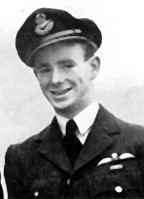Allegiance New Zealand Rank Squadron leader Battles and wars World War II | Name Raymond Hesselyn Battles/wars World War II | |
 | ||
Awards Member of the Order of the British Empire (MBE)Distinguished Flying Cross (DFC)Distinguished Flying Model (DFM) & Bar Service/branch | ||
Raymond Brown Hesselyn, (13 March 1921 – 14 November 1963) was a New Zealand fighter pilot and flying ace of the Second World War, credited with the destruction of 18.5 enemy aircraft while flying with the Royal New Zealand Air Force over Europe and the Mediterranean. Hesselyn's first 12 victories were claimed during the defence of Malta in 1942. He later collaborated in the writing of Spitfires over Malta, a book about his experiences on the island, before he was shot down and taken a prisoner of war in October 1943. Liberated in 1945, he transferred to the Royal Air Force in 1947 and attained the rank of squadron leader before his death in 1963, aged 42.
Contents

Early life
Hesselyn was born in Dunedin, New Zealand, on 13 March 1921. In civilian life, he was a machinist.
Second World War
Hesselyn joined the New Zealand Territorial Force in 1939, transferring to the Royal New Zealand Air Force the following year. After training, he was posted to Britain in September 1941, joining first No. 61 Operational Training Unit (OTU), then No. 234 Squadron RAF as a flight sergeant.
In February 1942, Hesselyn was posted to Malta, flying a Spitfire Mk V from the deck of the aircraft carrier HMS Eagle, to the island and joining No. 249 Squadron RAF on 9 March 1942. On April Fools Day 1942, Hesselyn recorded his first two kills, a Bf 109 of JG 53 and a Ju 87 of StG 3. Later that month, he shot down another Bf 109 and Ju 87, and was awarded the Distinguished Flying Medal (DFM). The citation for the award, promulgated in a supplement to the London Gazette on 22 May 1942, read:
N.Z. 404362 Sergeant Raymond Brown HESSELYN, Royal New Zealand Air Force, No. 249 Squadron.
Sergeant Hesselyn is a skilful and gallant pilot. Undeterred by odds, he presses home his attacks with outstanding determination. He has destroyed 5 enemy aircraft, 2 of which he shot down in one engagement.
May proved to be just as productive, with Hesselyn claiming four 109s and a Ju 88 of KGruppe 806 over a four-day period. For this he received a Bar to his DFM, and was commissioned as a pilot officer. Before returning to England, he downed one more 109, for a total of 12 claimed victories.
During a spell at No. 61 OTU, Hesselyn and fellow No. 249 Squadron pilot, Flight Lieutenant Virgil "Paul" Brennan, collaborated with journalist Henry Bateson on writing Spitfires over Malta, an award-winning book based on Brennan and Hesselyn's experiences on Malta. In early 1943 Hesselyn joined No. 501 Squadron RAF, before going on to No. 222 Squadron RAF as a flight commander later in the year. He shot down two 109s of JG 3 on 17 August 1943, and received the Distinguished Flying Cross in October for his "great skill, courage and keenness" in downing 17 aircraft. His luck finally ran out on 3 October 1943. After downing at least one 109 (claiming three), bringing his total to 18 and 1 shared destroyed (possibly 20), he was forced to bail out of his burning plane and was taken prisoner. He was probably shot down by Fbw. Weigand of I./JG 26.
Hesselyn escaped once, but was recaptured and spent the rest of the war making repeated attempts to rejoin the fight. As a result of his conduct as a prisoner of war, he was made a Member of the Order of the British Empire in December 1945.
RAF career
Hesselyn transferred to the Royal Air Force after the Second World War, being appointed to a four-year commission as a pilot officer on 16 March 1947 (with seniority from 28 May 1943) while retaining his war substantive rank of flight lieutenant. The latter rank was made substantive the very next day (seniority from 28 November 1945), and he was granted a permanent commission in September 1948. Hesselyn's final promotion, to squadron leader, came on 1 January 1951.
Hesselyn died at RAF Hospital Uxbridge on 14 November 1963, aged 42.
